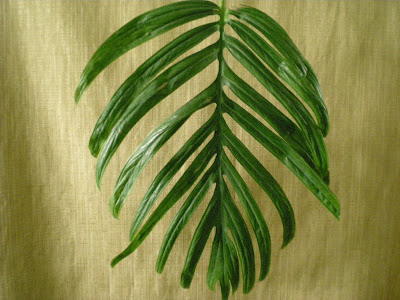Amydrium zippelianum is a robust herbaceous evergreen low climber which can reach 4 meters long with the stem of up to 3.5 cm in diameter...
Amydrium zippelianum, also called as Amydrium magnificum, Epipremnopsis magnifica, Epipremnopsis zippeliana, Epipremnum asperatum, Epipremnum elmerianum, Epipremnum luzonense, Epipremnum magnificum, Epipremnum mampuanum, Epipremnum philippinense, Epipremnum sorsogonense, Epipremnum zippelianum, Pothos miniatus, Rhaphidophora warburgii, Rhaphidophora zippeliana, is a species of the genus Amydrium. This species was described by Dan Henry Nicolson in 1968.
IDENTIFY AMYDRIUM ZIPPELIANUM
Amydrium zippelianum is native from Central Malesia to New Guinea. It is found growing on trees and rocks, in shady locations, in primary to disturbed lowland to mid-elevation rainforest, occasionally in regrowth or as a weed in plantations in Philippines, Sulawesi, Halmahera, Talaud Islands, Irian Jaya, Papua New Guinea at elevations of 30 - 1800 meters above sea level.
It is a robust herbaceous evergreen low climber which can reach 4 meters long with the stem of up to 3.5 cm in diameter and aerial roots at the nodes. The bright green leaves are distichously alternate, simple, ovate to rotund in outline, 70-125 cm x 60-90 cm (usually smaller in cultivation), cordate at base, acute to acuminate at apex, deeply laciniate, venation clearly reticulate.
This species blooms from the inflorescence that produced at the tip of clinging stems, subtended by several quickly blackening, later decomposing dense-fibrous cataphylls. The spadix is sessile or pedunculate, cylindrical, 6-8 cm long and 1.5-2 cm in diameter, initially yellow, surrounded by a fleshy spathe ovate-oblong, 14 cm long and 6 cm broad, yellow which quickly blackens, deciduous. The flowers are bisexual, without corolla, and fruit a fleshy berry, whitish-green to orange, 1-2-seeded.
AMYDRIUM ZIPPELIANUM CARE AND CULTURE
Cultural information should only be used as a guide, and should be to be adapted to suit you. Your physical location; where you grow your plants, how much time you have to devote to their care, and many other factors, will need to be taken into account. Only then can you decide on the cultural methods that best suit you and your plants.
Light:
Amydrium zippelianum grow best in medium to bright indirect light with light level of 10000-20000 lux. While it is tolerant of lower light conditions, you may notice leggy growth as a result. It can withstand 3 hours of direct sunlight but the plant should avoid to get too much direct sun because the leaves will burn. Dappled sunlight is ideal.
Temperature:
This species can grow in USDA zone 11-13. It prefers average to warm temperatures of 18-29 °C. Do not expose the plant to temperatures below 15 °C even for a short time because cold air will damage the foliage. Avoid cold drafts and sudden temperature changes.
Humididty:
Amydrium zippelianum grow best with the humidity level of 50% - 60%. It will thrive in almost any environment, but if you want to give it a special treat, gently mist it once a week. It's best to mist your plant in the morning so the water has plenty of time to evaporate before evening.
Substrate and growing media:
The plant need a well-aerated, quick-draining potting soil that dries out quickly. It thrive in moist soils with high organic matter and grow best when provided with a mossy post or burlap wrapped pole to climb. If given a trellis, it will climb and its leaves will become bigger and more fenestrated.
You can use a blend of large-chunk orchid bark, coarse-grade perlite, and peat moss at equal ratios; and then add about 10% charcoal which helps remove toxicities that can build up (over many months) in the potting mix.
Watering:
Water the plant once weekly. Allow the potting mix to dry out before watering. Water more frequently during warmer months and growth season. Generally, the plant will droop to show that it needs more water. Do not overwater or keep the soil wet for too long, as this will encourage root rot. If the leaves are yellowing due to overwatering, skip a week or two of watering.
Fertilizer:
Feed the plant between every two weeks and once per month during their growing season with a balanced houseplant fertilizer diluted to half strength. In the late fall and winter, when growth has slowed down, and the plant is dormant, do not fertilize your plant. Too much fertilizer can burn the foliage of your plant. Before applying fertilizer in any form, make sure the soil is damp.
Pruning:
Trim aerial roots if the plant get too unruly for the space, though tucking them back into the pot is preferred. Unlike some other houseplants, their roots do not damage surfaces.
Pests and diseases:
Wiping dust or debris with a damp sponge or paper towel will keep the plant clean and avoidant of pests. Common pests include mealybugs, aphids, thrips, scale and spider mites. If any are found on the foliage, spray the plant with a direct water stream. Leaves can also be washed with insecticidal soap.
The plant can also develop bacterial diseases such as leaf spot and root rot. Examine the plant periodically for signs of disease and use recommended fungicide and destroy the affected leaves. Correct application and timing are critical.
Propagation:
Amydrium zippelianum can be propagated by stem cuttings. Stem sections of 10-15 cm long, after removal of leaves, can be placed on a tray filled with an open, humus-rich soil mix at a minimum temperature of 22°C. Rooting takes place in about 2 weeks, and new growth begins from the nodes in about 4 weeks. Once growing strongly, the stem section can be cut into pieces, each bearing a rooted portion, and planted individually.

















COMMENTS